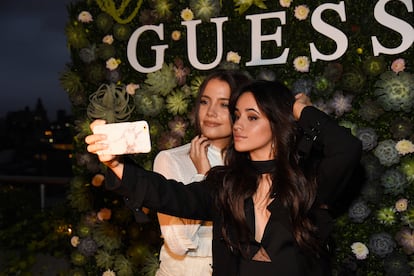Unwanted jeans and a mine of supermodels: How Guess forged its success
After more than 40 years in the premium denim market, the brand is reinventing itself by innovating the production process

“It’s a mixture of intuition and instinct.” That’s how the Marciano family remembers the unexpected success, more than 40 years ago, of the two pairs of jeans that the brothers Paul, Georges, Armand and Maurice created almost by accident: “At a time when jeans were a workday staple of the American wardrobe, Guess reclaimed denim for fashion.” The two models were both slim-fit silhouettes at a time when the style was out of vogue. The first one, called Marilyn after the actress who inspired the cut, had ankle zippers. The second, Exposed Button, received its name from the exposed buttons, with no flap covering the closure. “The stores at first received them with skepticism, but we did not give up. Bloomingdale’s sold two dozen in a couple of hours, and they ran out of stock in days.”
They quickly expanded the business to other types of garments. In 1985, in order to bring their project closer to that of a common fashion brand, they decided to carry out campaigns supervised and produced by the brothers themselves. As the brand says, “they have become part of popular culture.” Eva Herzigova, Carre Otis and Claudia Schiffer posed in their advertisements when they were still unknown. It could be said that Guess was their catapult to the international catwalks.
In recent years, celebrities such as Hailey Baldwin (still unknown at the time, when she posed in 2016), Camila Cabello, Jennifer Lopez and Sydney Sweeney have embodied the sensual and powerful image they seek to project: “We see Guess as an attitude, and we believe that’s part of success. It doesn’t matter what you wear, but how you wear it. That’s why we always look for models that we consider independent and comfortable in their skin, whether they are famous or not. In that sense, we feel very good about the changes that the industry is making towards diversity,” they say.

In the last two decades, Guess went public and greatly multiplied its product lines. Now, it has launched a house line, in addition to children’s clothing and the Marciano dresses. It expanded its sizing up to size 48 and gradually moved closer to sustainability, starting, of course, with denim: “It is the basis of the brand and the starting point of each collection we make. This year, for example, we have introduced bamboo fibers into the clothing,” the Marcianos explain. The design of the jeans has not changed, but their manufacturing process has: from fabrics made from tencel and modal, both made from cellulose, to natural dyeing systems and biodegradable elastic fibers.
For five years, they have been collaborating with the prestigious Spanish company Jeanología, famous for exporting manufacturing strategies that reduce emissions and water consumption. “Consumer behavior has changed enormously in this decade,” the Californian firm explains. “Brand loyalty no longer exists. Now what matters is price and the impact of the garment. So our main challenge is to offer quality clothing at affordable prices, and for that we have to invest wisely in the appropriate infrastructure and technology.” But reducing costs or increasing profit margins by producing cheaply is not an option for them: “Fashion by definition evolves and reinvents itself, but the changes in terms of sustainability in the short term are going to be radical. It is a challenge for all of us who are part of this, and a challenge that we have to face as soon as possible.”
Sign up for our weekly newsletter to get more English-language news coverage from EL PAÍS USA Edition
Tu suscripción se está usando en otro dispositivo
¿Quieres añadir otro usuario a tu suscripción?
Si continúas leyendo en este dispositivo, no se podrá leer en el otro.
FlechaTu suscripción se está usando en otro dispositivo y solo puedes acceder a EL PAÍS desde un dispositivo a la vez.
Si quieres compartir tu cuenta, cambia tu suscripción a la modalidad Premium, así podrás añadir otro usuario. Cada uno accederá con su propia cuenta de email, lo que os permitirá personalizar vuestra experiencia en EL PAÍS.
¿Tienes una suscripción de empresa? Accede aquí para contratar más cuentas.
En el caso de no saber quién está usando tu cuenta, te recomendamos cambiar tu contraseña aquí.
Si decides continuar compartiendo tu cuenta, este mensaje se mostrará en tu dispositivo y en el de la otra persona que está usando tu cuenta de forma indefinida, afectando a tu experiencia de lectura. Puedes consultar aquí los términos y condiciones de la suscripción digital.
More information
Archived In
Últimas noticias
Most viewed
- Oona Chaplin: ‘I told James Cameron that I was living in a treehouse and starting a permaculture project with a friend’
- Reinhard Genzel, Nobel laureate in physics: ‘One-minute videos will never give you the truth’
- Sinaloa Cartel war is taking its toll on Los Chapitos
- Why the price of coffee has skyrocketed: from Brazilian plantations to specialty coffee houses
- Silver prices are going crazy: This is what’s fueling the rally











































